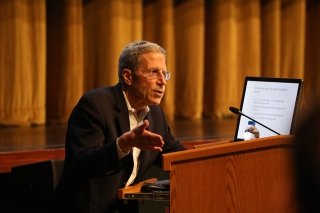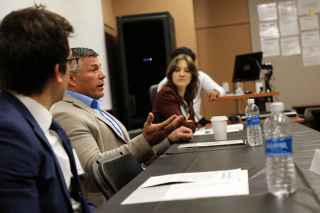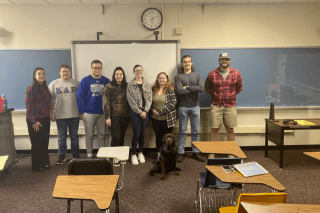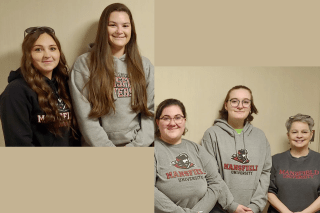Economics lecture focused on elections
Posted:
Harvard professor spoke on electing presidents

BLOOMSBURG—Is there a better way to elect presidents? Eric Maskin, Adams University Professor of Economics and Mathematics at Harvard University, visited Bloomsburg University of Pennsylvania to explore the solution to this problem in his lecture “How Should We Elect Presidents?”
Maskin received his bachelor's and Ph.D. from Harvard University and was a postdoctoral fellow at Cambridge University. He has worked as a part of the faculty at MIT, the Institute for Advanced Study, and Harvard. He was awarded the Nobel Prize in Economics in partnership with Leonid Hurwicz and Roger Myerson in 2007.
In his lecture, Maskin primarily examined the outcomes of the GOP primary elections in 2016 when Donald Trump won the party’s nomination for president. He observed that although Trump won the nomination, in 17 states, the anti-Trump vote was larger. In these events, Trump won despite losing the majority vote because the remaining votes were split between multiple other candidates.
“Vote splitting ensured nomination for Donald Trump,” said Maskin, “Whereas in a one-on-one comparison with any other candidate, he would have lost.”
“Vote splitting ensured nomination for Donald Trump,” said Maskin, “Whereas in a one-on-one comparison with any other candidate he would have lost.”
However, when discussing “better” voting systems, what exactly does better mean? Maskin says that a better voting system allows voters to give more information about their candidate preferences. “The solution to our problem is to allow voters to provide rankings of the candidates.” Already, states like Alaska, Maine, and New York have incorporated ranking systems into how they vote for Congressional nominees and mayoral candidates.
When allowing voters to rank the candidates, two new systems of voting arise: the True Majority Rule (Condorcet’s Method) and ranked-choice voting.
Under Condorcet’s Method, voters submit rankings of the candidates, and a winner is elected according to which candidate beats all others in head-to-head pairwise comparisons. Using the example of the 2016 primaries, John Kasich would have won under this method; in head-to-head comparisons, he beat Trump with 60% of the votes and Marco Rubio with 65%.
With ranked-choice voting, if one candidate has a majority of the votes they win. Otherwise, the candidate with the least amount of first-place votes is eliminated from the ballots, and the remaining candidates are shifted up a ranking level to fill the empty slot. This process continues until one candidate has the majority. With the 2016 primary example, Rubio would have won the nomination with 60% of the votes.
But which of these alternative voting methods is the “best” better voting method? Maskin says the True Majority Rule is the obvious choice. He explained this through a theorem he developed with Cambridge University professor Partha Dasgupta.
“The Dasgupta-Maskin Majority Domination Theorem asserts that if a particular voting method works well for some class of rankings, then the True Majority Rule will as well,” said Maskin, “and it will work more often than any other method.”
As far as adopting a new voting method in the United States, Maskin remains hopeful for reform. “Voting methods are decided at the state level; it doesn’t require any Constitutional change,” explained Maskin. “Maine and Alaska have already adopted ranked-choice voting and more states are planning to follow them. From there, it is only a small step to move to the True Majority method.”



